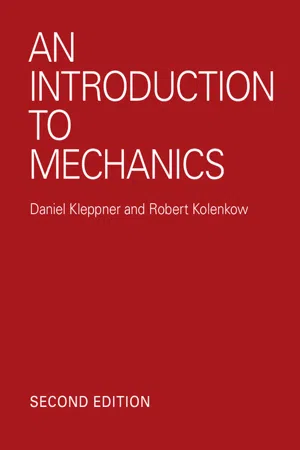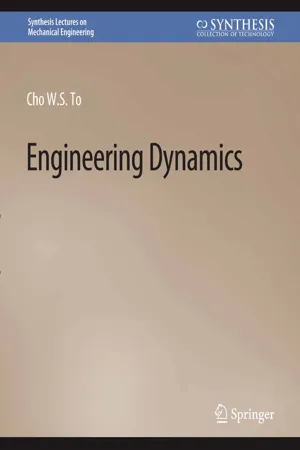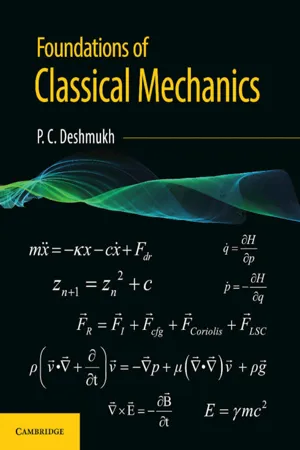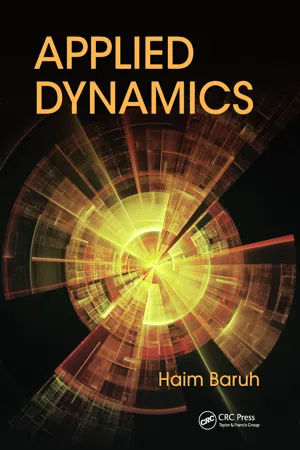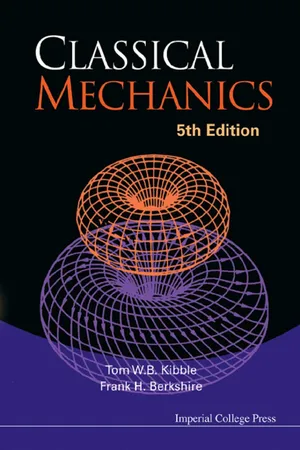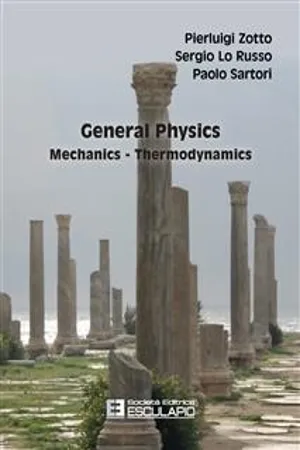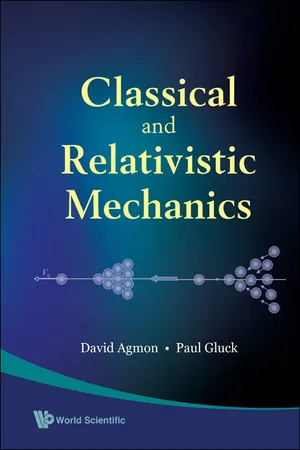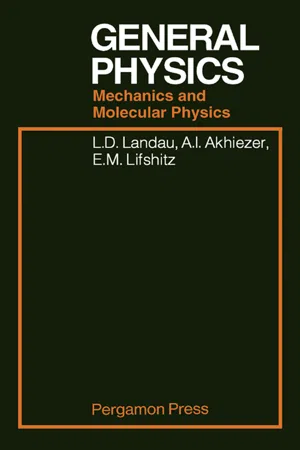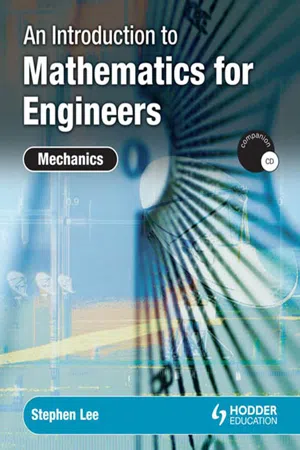Technology & Engineering
Angular Momentum of a Rigid Body
Angular momentum of a rigid body is a measure of its rotational motion. It is the product of the body's moment of inertia and its angular velocity. This quantity is conserved in the absence of external torques, making it a fundamental concept in the analysis of rotating systems in physics and engineering.
Written by Perlego with AI-assistance
Related key terms
1 of 5
12 Key excerpts on "Angular Momentum of a Rigid Body"
- eBook - PDF
- Daniel Kleppner, Robert Kolenkow(Authors)
- 2013(Publication Date)
- Cambridge University Press(Publisher)
Although fields lie beyond the scope of particle mechanics, it turns out that fields can possess energy, momentum, and angular momentum. When the angular momentum of the field is taken into account, the angular momentum of the entire particle–field system is conserved. The situation, in brief, is that Newtonian physics is incapable of pre-dicting conservation of angular momentum but no isolated system has yet been encountered experimentally for which the total angular mo-mentum is not conserved. We conclude that conservation of angular mo-mentum is an independent physical law, and until a contradiction is dis-covered, our physical understanding must be guided by it. 8.6 Rigid Body Rotation and the Tensor of Inertia The governing equation τ = d L / dt for rigid body motion bears a formal resemblance to the translational equation of motion F = d P / dt . There is, however, an essential di ff erence between them. Linear momentum and center of mass motion are simply related by the vector equation P = M V where M is a scalar, a simple number. P and V are therefore always parallel. The connection between L and ω is not so simple. For fixed axis rotation, L = I ω , and it is tempting to suppose that for any general rotation L = I ω , where I is a scalar. However, this cannot be correct, since we know from our study of the rotating skew rod, Example 8.4 , that L and ω are not necessarily parallel. In this section, we shall develop the general relation between angular momentum and angular velocity, and in Section 8.7 we shall attack the problem of solving the equations of motion. 8.6.1 Angular Momentum and the Tensor of Inertia We begin by showing that to analyze the rotational motion of a rigid body, we really need consider only the angular momentum about the center of mass as origin. - eBook - PDF
- Cho S.(Author)
- 2022(Publication Date)
- Springer(Publisher)
In rigid bodies aside from the linear impulse there is the angular impulse. For simplicity, in this section impulse, momentum, and angular momentum are confined to 2D space. 154 8. DYNAMICS OF RIGID BODIES With reference to Section 5.2, the equation of translational motion for a rigid body of constant mass m can be written as n X i D1 * F i D m * a G D d.m * v G / dt ; where m * v G is the linear momentum and * v G is the velocity at the mass center G. One can multiply both sides of this equation by dt and integrating between times t 1 and t 2 such that Z t 2 t 1 n X i D1 * F i dt D Z . * v G/ 2 . * v G/ 1 d.m * v G / D m * v G 2 m * v G 1 or upon re-arranging, one has m * v G 1 C Z t 2 t 1 n X i D1 * F i dt D m * v G 2 : (8.29) This equation is called the principle of linear impulse and momentum for a rigid body. It simply states that the final momentum of a rigid body acting on by a system of impulses is equal to the vector sum of its initial momentum and the impulses during the time interval in question. Similarly, the equation of rotational motion from Equation (8.25c) is n X i D1 .M G / z i D I G ˛ D I G d! dt : Multiplying both sides of this equation by dt and integrating between times t 1 and t 2 such that Z t 2 t 1 n X i D1 .M G / z i dt D Z ! 2 ! 1 I G d! D I G ! 2 I G ! 1 or upon re-arranging, one has I G ! 1 C Z t 2 t 1 n X i D1 .M G / z i dt D I G ! 2 ; (8.30) where the second term on the lhs is interpreted as the system of angular impulses. Equa- tion (8.30) is called the principle of angular impulse and momentum for a rigid body. It simply states that the final Angular Momentum of a Rigid Body acting on by a system of angular impulses is equal to the vector sum of its initial angular momentum and the system of impulses during the time interval in question. Equations (8.29) and (8.30) are illustrated in Figure 8.11. - eBook - PDF
- P. C. Deshmukh(Author)
- 2019(Publication Date)
- Cambridge University Press(Publisher)
The linear momentum can be considered for all algebraic purposes to be a ‘free’ vector, in the sense that two linear momenta of equal magnitudes and same direction are equal (in Euclidean 3d space), no matter where they are placed; i.e., no matter where the tip or the tail of the arrows which represent them. The same is not true, in general, about two angular momenta, since the very definition of the angular momentum = r × p involves the position vector r which is referenced to a particular point in space. This reference point must therefore always be specified while analysing the angular momentum. For this reason, the angular momentum is often called as the moment of momentum. Likewise, any change in it can be effected only by the moment of the force, t = r × F , also about the same point. The above definition is readily extended to a set of discrete particles, or even to a continuous medium. The angular momentum of a system of discrete particles about a point, like that of the asteroids in the belt between Mars and Jupiter about the Sun, is given by their sum, i i i i i r p ∑ ∑ = × , where r i is the position vector of the center of mass of the i th asteroid with respect to the Sun, and p i is the product of the mass of the asteroid with instantaneous linear velocity of the center of mass. For continuous mass distributions, these summations are easily extended into integrals over a line, a surface or a volume, as appropriate. In the case of a linear mass distribution that has a mass density l(r ) at a point whose position vector is r relative to a point O, the mass of an infinitesimal line segment ds located at (r ) is l(r )ds. The angular momentum of the extended 1-dimensional slim linear object, like a wire, is therefore 1d r r v r ds − = × ∫ wire λ( ) ( ) , where v (r ) is the instantaneous velocity of the tiny mass element l(r )ds. - Raymond Serway, John Jewett(Authors)
- 2018(Publication Date)
- Cengage Learning EMEA(Publisher)
Consider a rigid object rotating about a fixed axis that coincides with the z axis of a coordinate system as shown in Figure 11.7. Let’s determine the angular momentum of this object. Each particle of the object rotates in the xy plane about the z axis with an angular speed v. The magnitude of the angular momentum of a particle of mass m i about the z axis is m i v i r i . Because v i 5 r i v (Eq. 10.10), we can express the magni- tude of the angular momentum of this particle as L i 5 m i v i r i 5 m i ( r i v ) r i 5 m i r i 2 v The vector L S i for this particle is directed along the z axis, as is the vector v S . We can now find the angular momentum (which in this situation has only a z component) of the whole object by taking the sum of L i over all particles: L z 5 o i L i 5 o i m i r i 2 v 5 S o i m i r i 2 D v L z 5 Iv (11.16) where we have recognized o i m i r i 2 as the moment of inertia I of the object about the z axis (Eq. 10.19). Notice that Equation 11.16 is mathematically similar in form to Equation 9.2 for linear momentum: p S 5 m v S . Now let’s differentiate Equation 11.16 with respect to time, noting that I is con- stant for a rigid object: dL z dt 5 I dv dt 5 Ia (11.17) where a is the angular acceleration relative to the axis of rotation. Because dL z / dt is equal to the net external torque (see Eq. 11.15), we can express Equation 11.17 as o t ext 5 Ia (11.18) That is, the net external torque acting on a rigid object rotating about a fixed axis equals the moment of inertia about the rotation axis multiplied by the object’s angular acceleration relative to that axis. This result is the same as Equation 10.18, which was derived using a force approach, but we derived Equation 11.18 using the concept of angular momentum. As we saw in Section 10.5, Equation 11.18 is the mathematical representation of the rigid object under a net torque analysis model.- eBook - PDF
- Haim Baruh(Author)
- 2014(Publication Date)
- CRC Press(Publisher)
11 Dynamics of Three-Dimensional Rigid Body Motion 11.1 Introduction This chapter extends the developments and derivations in previous chapters associated with rigid body dynamics to three-dimensional motion. Linear and angular momentum expressions are developed and used in conjunction with the translational and rotational laws of motion. Analytical methods that make use of Lagrange’s and Kane’s equations are used for obtaining the describing equations. When obtaining the describing equations for rigid bodies, we have a number of choices in selecting the motion variables. We will make use of these choices in this chapter and develop several forms of the describing equations. The use of a reference frame attached to the body continues to be the most common case for rigid bodies, because the elements of the inertia matrix remain constant when using a set of body-fixed axes. For axisymmetric bodies, use of the shape frame is attractive, as it leads to simpler expressions for angular velocity and acceleration. This chapter also develops tools to analyze the qualitative behavior of three-dimensional rigid body motion, such as stability, motion integrals, work-energy principles, and impulse-momentum principles. 11.2 Linear and Angular Momentum Consider a rigid body, such as the one in Figure 11.1, with center of mass G . Also consider an arbitrary point B , located on or off the body, and a differential element dm . As discussed in Chapter 4, the linear momentum of the body, denoted by p , is defined as p = Z body v dm = Z body d r dt dm (11.1) The position of the differential element is r = r G + ρ (11.2) where ρ connects the center of mass with the differential element. Recall from Chapter 4 that R body ρdm = 0 . Using relative velocity relationships, the velocity of the differential element is expressed as v = v G + ω × ρ (11.3) 553 554 Applied Dynamics O B G r r G r B s v dm r G/B FIGURE 11.1 A rigid body. - eBook - ePub
- Tom W B Kibble, Frank H Berkshire(Authors)
- 2004(Publication Date)
- ICP(Publisher)
So far we have assumed that the axis about which the rigid body is rotating is fixed. We now go on to consider how it moves if only one point on the axis is fixed. As we shall see, rapidly rotating bodies have great stability, which forms the basis, for example, of the gyroscope.We suppose that the rigid body is free to rotate about a fixed smooth pivot, and that initially it is rotating freely about a principal axis, say e3 . Then, if the angular velocity is ω = ωe3 , the angular momentum will be J = I3 ωe3 . So long as no external force acts on the body the angular momentum equation (9.2) tells us thatso the axis will remain fixed in space and the angular velocity will be constant. (This would not be true if the axis of rotation were not a principal axis. We shall see what happens in that case later.)Now suppose that a small force F is applied to the axis at a point r (see Fig. 9.5 ). Then the equation of motion becomesThis force will cause the axis to change direction, and the body will therefore acquire a small component of angular velocity perpendicular to its axis e3 . However, provided the force is small enough, the angular velocity with which the axis moves will be small in comparison to the angular velocity of rotation about the axis. In that case, we may neglect the angular momentum components normal to the axis, and again writeFig. 9.5Since the moment r ⋀ F is perpendicular to ω, the magnitude of the angular velocity does not change. (Recall that However, its direction does change, and the axis will move in the direction of r ⋀ F, that is perpendicular to the applied force.The effect may be rather surprising at first sight. However, it is easy to see it in action in, for example, a freely rolling bicycle wheel (see Fig. 9.6 ). If the wheel leans to the right, it will not necessarily fall over, as it would if it were not rotating, but will turn to the right. The force F in this case is the force of gravity, which produces a moment about a horizontal axis, as shown in Fig. 9.6 . Thus, in a small time interval dt, the angular velocity ω of a wheel acquires a small additional horizontal component, dω - eBook - PDF
- Pierluigi Zotto, Sergio Lo Russo, Paolo Sartori(Authors)
- 2022(Publication Date)
- Società Editrice Esculapio(Publisher)
8.17 Relation between Angular Velocity and Angular Momentum Let us consider again the relationship between angular momentum and angular velocity obtained in paragraph 8.4 in the light of the further knowledge we have just learnt. The Angular Momentum of a Rigid Body, rotating with angular velocity ω , about a point on its rotation axis is L O = r i × m i v i ( ) i ∑ = r i × m i ω × r i ( ) ⎡ ⎣ ⎤ ⎦ i ∑ with r i = x i u x + y i u y + z i u z ω = ω x u x + ω y u y + ω z u z ⎧ ⎨ ⎪ ⎩ ⎪ We have ω × r i = u x u y u z ω x ω y ω z x i y i z i = ω y z i − ω z y i ( ) u x − ω x z i − ω z x i ( ) u y + ω x y i − ω y x i ( ) u z and r i × ω × r i ( ) = u x u y u z x i y i z i ω y z i − ω z y i ω z x i − ω x z i ω x y i − ω y x i that is r i × ω × r i ( ) = ω x y i − ω y x i ( ) y i − ω z x i − ω x z i ( ) z i ⎡ ⎣ ⎤ ⎦ u x + − ω x y i − ω y x i ( ) x i − ω y z i − ω z y i ( ) z i ⎡ ⎣ ⎤ ⎦ u y + + ω z x i − ω x z i ( ) x i − ω y z i − ω z y i ( ) y i ⎡ ⎣ ⎤ ⎦ u z thus the components of angular momentum L O are L o, x = m i ω x y i 2 − ω y x i y i − ω z x i z i + ω x z i 2 ( ) ⎡ ⎣ ⎤ ⎦ i ∑ = I xx ω x − I xy ω y − I xz ω z L o, y = m i ω y x i 2 − ω x x i y i − ω z y i z i + ω y z i 2 ( ) ⎡ ⎣ ⎤ ⎦ i ∑ = I yy ω y − I xy ω x − I yz ω z L o, z = m i ω z x i 2 − ω x x i z i − ω y y i z i + ω z y i 2 ( ) ⎡ ⎣ ⎤ ⎦ = I zz ω z − I yz ω y − I xz ω x i ∑ ⎧ ⎨ ⎪ ⎪ ⎪ ⎪ ⎩ ⎪ ⎪ ⎪ ⎪ If the axes of the reference system are the principal inertia axes, the inertia products are null and therefore the angular momentum is given by Chapter 8 Dynamics of a Rigid Body 189 L O = I xx ω x u x + I yy ω y u y + I zz ω z u z If the rotation axis is coincident with a principal inertia axis, for instance z thus ω = ω u z , we obtain the relationship of paragraph 8.4 L O = I zz ω u z , meaning that the angular momentum is parallel to the angular velocity, i.e. - eBook - PDF
- David Agmon, Paul Gluck;;;(Authors)
- 2009(Publication Date)
- WSPC(Publisher)
The third term is kinetic energy of the particles relative to the com. We may therefore write 1 1 N ^ ^ M ^ -E ^ ' 2 (11.8) 11.4 Rigid bodies A rigid body is a collection of particles such that the distance between each pair remains fixed, independent of the force applied to the body. It is a special case of a system of particles, and therefore the results of examples 6 and 8 apply to it. There is a theorem due to Charles, according to which the general motion of a rigid body is compounded of a translation and a rotation, whereby the rotation is about a suitable point in space, often conveniently chosen to be the com of the body. 393 i nc iiiuiiiciii ui niciiia is a geometrical property of a body which is useful in rigid body dynamics. In essence, it describes the spatial distribution of the object with respect to the axis of rotation chosen, and therefore, like moment and angular momentum, is not an intrinsic property of the body but is axis-dependent As its name implies, it expresses the resistance of the body to changes in the angular velocity, much as mass is resistance to changes in the translational velocity. For a particle of mass m, at a perpendicular distance r from a given axis (AB in the figure), its moment of inertia / is defined by (see example 2, part c) I = mr For N particles we simply sum the above expression Z'*=I f?h n Here t is the perpendicular distance of the A'-th particle to the given axis. When the body is a continuous distribution of mass the above sum is replaced by the integral -1 rdm ill 3) The integration is carried out over the whole volume. - eBook - ePub
General Physics
Mechanics and Molecular Physics
- L D Landau, A. I. Akhiezer, E.M. Lifshitz(Authors)
- 2013(Publication Date)
- Pergamon(Publisher)
27). Since every point in the body moves in a circle round the axis of rotation, the velocity v i is tangential to the circle in Fig. 27, i.e. is in a plane at right angles to OZ. We can resolve the vector R i into two vectors, one along the axis and the other r i perpendicular to the axis. Then the product m i r i × v i is just the part of the angular momentum which is parallel to the axis Z (it will be recalled that the vector product of two vectors is perpendicular to the plane through those vectors). Since the vectors r i and v i are mutually perpendicular (being a radius of the circle and a tangent to it), the magnitude of the product r i × v i is just r i v i, where r i is the distance of the element m i from the axis of rotation. Finally, since v i = Ω r i, we conclude that the component of the angular momentum of the element m i along the axis of rotation is m i r i 2 Ω. The sum m 1 r 1 2 Ω + m 2 r 2 2 Ω + · · · gives the required component L z of the total angular momentum of the body along the axis Z. This quantity is also called the angular momentum of the body about that axis. FIG. 27 When the common factor Ω is removed from the above sum there remains a sum which is just the expression for the moment of inertia I. Thus we have finally L z = I Ω, i.e. the angular momentum of the body is equal to the angular velocity multiplied by the moment of inertia of the body about the axis of rotation. The analogy between this expression and the expression m v for the momentum of a particle should be noticed: the velocity ν is replaced by the angular velocity and the mass is again replaced by the moment of inertia. If no external forces act on the body, its angular momentum remains constant: it rotates “by inertia” with a constant angular velocity Ω. Here the constancy of Ω follows from that of L z because we have assumed that the body itself is unchanged during the rotation, i.e. its moment of inertia is unchanged - eBook - PDF
- Stephen Lee(Author)
- 2014(Publication Date)
- CRC Press(Publisher)
Now consider a more complex rigid body rotating with an angular speed . . Think of it as being made up of a lot of small particles of mass, m 1 , m 2 , …. A typical particle of mass m p , moving in its circle of radius r p round the axis of rotation with angular speed . , has a speed r p . (see figure 20.5). Its kinetic energy is 1 2 m p r 2 p . 2 . Figure 20.5 Summing over all particles gives the total kinetic energy as 1 all p 1 2 m p r 2 p . 2 = 1 2 1 all p m p r 2 p . 2 (since . is the same for all particles). Moment of inertia The quantity 1 all p m p r 2 p is called the moment of inertia of the body about the axis and is conventionally denoted by the letter I . Moment of inertia has dimensions ML 2 and so its SI unit is 1kg m 2 . The moment of inertia ( I or m p r 2 p ) of a body about an axis is a scalar quantity which depends on the manner in which the particles of the body are distributed about that particular axis. Its value varies according to the position and orientation of the axis. Once you know the moment of inertia of a body about a given axis, you can find its kinetic energy when rotating about that axis. It is 1 2 I . 2 . Notice that there is an analogy between this expression for kinetic energy and the kinetic energy, 1 2 mv 2 , of a particle. The mass, m , can be replaced by I and the speed, v , by the angular speed . (or ) to give 1 2 I . 2 (or 1 2 I 2 ). You will see later that there are similar analogies between other quantities you have used for the motion of particles and those which apply to the rotation of a rigid body. ‘Inertia’ is a word which is used to describe a resistance to change in motion; it is sometimes used in place of mass. The larger the mass, or inertia, of a particle, the greater the amount of energy required to change its motion. In the same way, the energy required to change rotational motion is greater for bodies with large moments of inertia. - eBook - ePub
- John Chiasson(Author)
- 2022(Publication Date)
- Wiley(Publisher)
5 Rigid Body Rotational Dynamics 5.1 Moment of Inertia The equation s of motion of a rigid body that is constrained to rotate about a fixed axis are reviewed here briefly. Consider the cylinder shown in Figure 5.1. Figure 5.1 Cylinder constrained to rotate about a fixed axis. The approach here is to obtain the equations of motion of the cylinder by first obtaining an expression for its kinetic energy. To do so, denote the angular speed of the cylinder by and the mass density of the material making up the cylinder by. Then consider the cylinder to be made up of a large number of small pieces of material where the th piece has mass This is illustrated in Figure 5.2. Each piece of mass is rotating at the same angular speed so that the linear speed of is where is the distance of from the axis of rotation. The kinetic energy of is given by Figure 5.2 Cylinder is considered to be made up of small masses The total kinetic energy is then Dividing the cylinder into f iner and finer pieces so that and, the sum becomes the integral The quantity is called the moment of inertia. Using the kinetic energy of the cylinder may now be written as Taking the axle radius to be zero, the moment of inertia of the cylinder (assuming the mass density is constant) is computed to be where is the total mass of the cylinder. 5.2 Newton's Law of Rotational Motion The kinetic energy is now used to derive a relationship between torque and angular acceleration. Recall from elementary mechanics that the work done on a mass by an external force equals the change in its kinetic energy - eBook - PDF
Engineering Mechanics
Dynamics
- Benson H. Tongue(Author)
- 2012(Publication Date)
- Wiley(Publisher)
You know how to calculate the mass and rotational inertias, as well as the body’s acceleration. The translational equations of motion, assuming external forces and moments, are given by F = ˙ L which, for a constant mass, is just F = d(mv ) dt = m dv dt = ma (8.41) Our angular momentum equation of motion has the general form we saw 522 CH 8 KINEMATICS AND KINETICS OF RIGID BODIES IN THREE-DIMENSIONAL MOTION in Section 5.2, namely, M G = ˙ H G for the case in which we are summing applied moments M G about the center of mass G and M O = ˙ H O when we are summing applied moments M O about a fixed point O. Because we have expressed the body’s momentum in terms of body- fixed axes, the time derivative ˙ H of the angular momentum has two parts (6.24): ˙ H N = d dt S H + (ω × H ) where N represents the inertial reference frame and S represents the rotating frame of reference, which in this case coincides with our body’s x, y, z axes. If we express the applied moment as ∑ M = M 1 b 1 + M 2 b 2 + M 3 b 3 and the angular momentum as ∑ H = H 1 b 1 + H 2 b 2 + H 3 b 3 , then we will have M 1 = ˙ H 1 + (ω 2 H 3 − ω 3 H 2 ) (8.42) M 2 = ˙ H 2 + (ω 3 H 1 − ω 1 H 3 ) (8.43) M 3 = ˙ H 3 + (ω 1 H 2 − ω 2 H 1 ) (8.44) This expression simplifies if we use the principal axes for our x, y, z frame because all the products of inertia go to zero. In this case we will have what are termed Euler’s equations: M 1 = I xx α 1 + ω 2 ω 3 ( I zz − I yy ) (8.45) M 2 = I yy α 2 + ω 3 ω 1 ( I xx − I zz ) (8.46) M 3 = I zz α 3 + ω 1 ω 2 ( I yy − I xx ) (8.47) Notice that when we shift to principal axes we don’t get equations of the 8.8 EQUATIONS OF MOTION FOR A THREE-DIMENSIONAL BODY 523 form M 1 = I xx α 1 M 2 = I yy α 2 M 3 = I zz α 3 as you might have expected. The only way we could avoid the angular ve- locity terms is if the two cross products of inertia for a particular equation were equal.
Index pages curate the most relevant extracts from our library of academic textbooks. They’ve been created using an in-house natural language model (NLM), each adding context and meaning to key research topics.
